A powerful and practical all-terrain e-bike for hunting, commuting, or simply having fun.

An e-bike aiming to adventure in potentially remote areas needs serious power to deal with rough terrain; fortunately, QuietKat specced a beastly 1,000W Bafang rear-hub motor with 80 Nm of torque. In combination with the bike’s Kenda fat tires and Mozo suspension fork with 100 mm of travel, the Ranger is well-equipped to handle any and all types of terrain.
We experienced an impressively stable ride with great handling from the bike’s chunky off-road tires and 740mm handlebars. Depending on frame size, the Ranger sports either 20”x4” or 26”x4.5” fat tires that chew through dirt with ease. The bike’s wide handlebars offer precise steering for navigating tight trails or obstacles, ensuring that the Ranger stays firmly on course.
Whether loaded up with game, camping gear, or even a load of groceries, the Ranger has a substantial payload capacity of 325 lbs. The bike’s rear rack is welded to its beefed-up chainstays, allowing it to carry up to 100 lbs – but in case that doesn’t cut it, QuietKat offers two trailer options to make the job possible.
Those were the highlights from our time on the bike, but to learn more about its real world performance, read on to our full QuietKat Ranger review below!
Sponsor
Bike Category:Fat Tire/All-Terrain
Class 2 E-Bike:Throttle and Pedal Assist up to 20 mph (can be adjusted to Class 1, Class 3, or Unlimited)
Sponsor
QuietKat Ranger Video Review
ELECTRICAL SPECS & FEATURES
Battery: 16AH/48V | 768Wh | 10 lbs Display: Customizable LED Motor: 1000W Hub-Drive (VP0™) Headlight:Not Included Taillights:Not Included Pedal Assist: Eco, Trail, Boost Range: 24-48 Miles (claimed) Throttle: Thumb Throttle UL Certification:Coming soonWeight & Dimensions
Claimed weight: 65 lbs (82 lbs actual) Rider height range: under 5’-6” to over 6’-0” Maximum load on the rear rack: 100 lbs Total payload capacity: 325 lbs.Components & Accessories
Brakes:Tektro E-350 2-Piston Hydraulic Brakes, 203mm Rotors Fenders:None Fork:Mozo Coil Suspension Fork, 100mm Travel Frame: Alloy | Internal Cable Routing | Integrated Rack Drivetrain: SRAM 7-Speed, 36T chainring, 12-32T cassette Grips: Standard Rubber Lock-on Grips Saddle: Custom QuietKat Comfort Plus Saddle, Memory Foam Handlebar: 740mm Kickstand: Included Pedals: Wellgo Platform Tires: 26” x 4.5” (MD, LG) | 24″ x 4.0 (SM) Kenda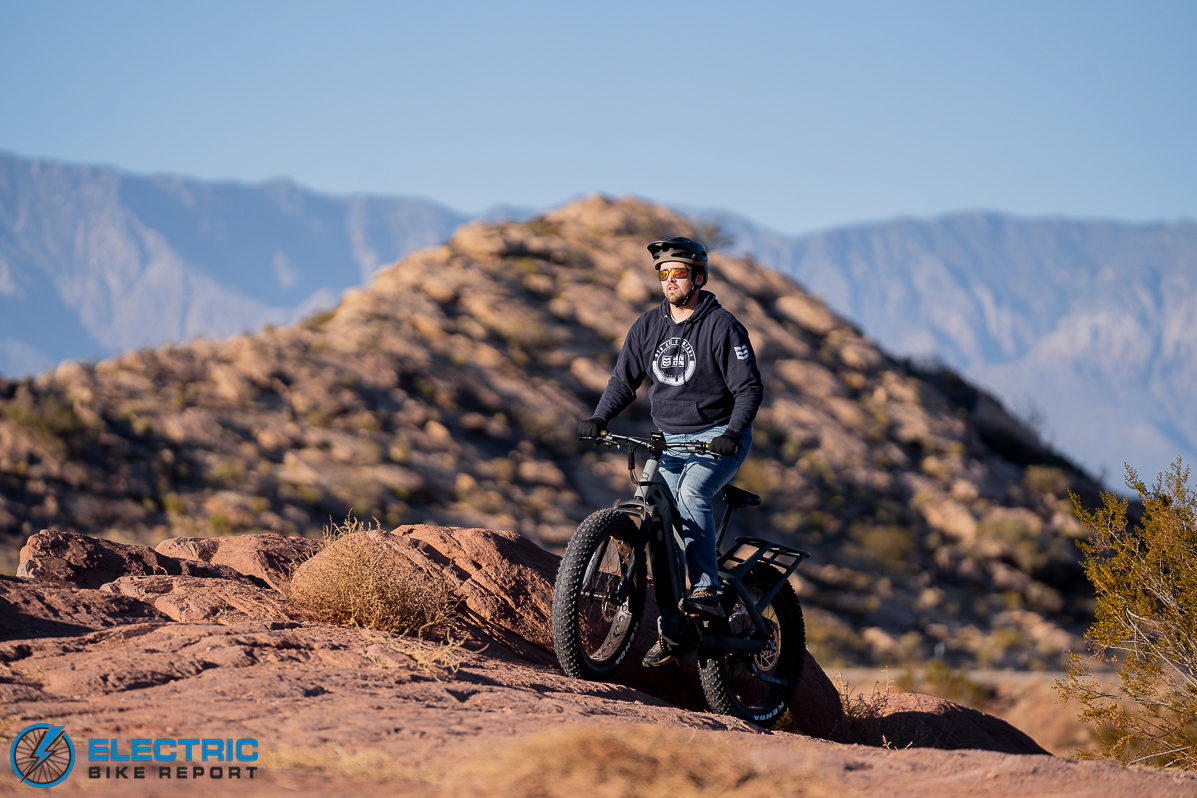
The overall size and stability of the Ranger made it feel very much at home in the wild.

With its 1,000W rear hub motor, there’s little that can stand in the bike’s way.

The 4.5” wide Kenda tires on our test bike provided plenty of grip for dirt and rocks.
To measure the QuietKat Ranger’s speed, I rode it on a local paved bike path first with no pedal assist and then moved up through its three pedal assist system (PAS) settings. I tested the Ranger in two of its four riding modes – first, in the Class 2 mode that it ships in with a 20 mph speed limit, and second, in its Class 3 mode with pedal assist up to 28 mph.
In Class 2 mode, I measured an even 10 miles per hour when pedaling the bike with no assistance; as an 82.5-lb bike with a long wheelbase, it proved bulky and tough to move without the motor (as is common with this style of e-bike). The lowest PAS setting, Eco Mode, rocketed the bike to a speedy 19.8 mph. Trail Mode managed a slight increase up to 20.4 mph, while Boost Mode finished off the test at 20.7 mph. This data showed a steady progression in measurable speed from Eco to Boost modes, but with a starting point so close to the ceiling, there was little room for differences.
In Class 3 mode, Eco Mode reached 22.7 mph, while Trail and Boost modes hit 26.7 and 26.6 mph respectively. Where the Class 2 data showed minimal control across three settings, this mode showed greater control between two settings; the slight difference between Trail and Boost modes was due only to changes in the path.
Even with the Ranger’s 1,000W rear hub motor, we were surprised by its hunger for speed in both riding modes; it is uncommon in our experience for there to be so little variance between PAS settings. With further testing, however, we learned that this pattern applied to the Ranger only when used on paved surfaces.
Sponsor

The Ranger can switch easily between Class 1, Class 2, Class 3, and Unlimited riding modes.

We thought the 7-speed drivetrain worked well within the bike’s Class 2 settings.

The down tube hosts the Ranger’s removable 48V, 768 Wh battery.
We’d prefer to see more variance in speed when riding on paved surfaces, but we appreciate the Ranger’s more controlled off-road feel. As a bike that is likely to be primarily used in rough, wild terrain, it showed that it has an appropriate level of power. Additionally, we expect it would be enough to handle difficult environments while hauling or towing a significant amount of weight.
During my testing of the Ranger’s throttle, I noticed that its power seemed to be linked to the bike’s PAS. In Eco Mode, the throttle felt reserved and took more time to get up to speed. In Boost Mode, however, the throttle was much more powerful and immediate, bringing the bike quickly up to its Class 2 max of 20 mph.
While we did not “officially” test the bike in its Unlimited setting, I did personally play with it during my personal evaluation. In this off-road-only riding mode, I was able to reach roughly 30 mph on paved surfaces using either the throttle or PAS.
We performed two separate Range Tests with the Ranger to evaluate the life of its 48V, 768 watt-hour (Wh) battery and the efficiency of its 1,000W rear-hub motor. We pedaled the bike in its Class 2 riding mode along our local network of bike paths, while using Strava to track our progress.
By testing the bike in Eco Mode and Boost Mode, we established a real-world bracket of values; we measured results of 27.6 and 30.2 miles using the bike’s highest and lowest assist settings respectively.
When compared to similar all-terrain e-bikes we have tested, the Ranger’s results were relatively unusual, though there are clear explanations for these differences.
First, it is uncommon for the high- and low-end values to be so close, but considering the results of our Speed Test – where there was little discernible difference in speeds on paved surfaces – this tracks. With nearly identical motor output in Eco and Boost Modes, we should expect the values to be similar.
Second, while the Ranger’s range may seem average-to-low in comparison to similar e-bikes, we must consider its battery capacity and its type of motor.
Most of the all-terrain bikes we have tested have been host to mid-drive motors, which are naturally more efficient than rear-hubs due to their reliance on input from the rider. The Ranger uses both a torque and a cadence sensor to inform motor output, but in our testing, seemed to rely more on the less-efficient cadence sensor.
The bike’s shorter range also corresponds to a difference in battery capacity. With one exception, the Ranger’s 768 Wh battery was smaller than average among the all-terrain e-bikes we’ve tested, meaning that its “gas tank” ran dry earlier than those of its competitors.
Regardless, the Ranger turned out to be more efficient than we expected based on its motor and battery specs; this is likely a result of its torque sensor. We anticipated that our Boost Mode test would last only 61 minutes with a distance of roughly 21 miles. Our final results showed a 55% increase in time and a 31% increase in distance.
We found the bike’s range to be practical in our testing, though we also did not use the bike to haul cargo (or game). Those who plan to cover a longer round trip or carry a significant payload may want to consider adding QuietKat’s optional solar charging station that allows for refueling literally anywhere the sun shines.
Sponsor
With its throttle, the bike steadily climbed with an average speed of 11.4 mph, resulting in a start-to-finish time of 1 minute, 35 seconds. When our test rider Justin added his effort to the mix using Boost Mode, his speed increased to 13.1 mph. There, he reached the end of the path in 1 minute, 23 seconds.
Comparing the Ranger to similar e-bikes we have tested is somewhat of an apples and oranges situation; most of the all-terrain bikes we have data for used mid-drive motors, which behave much differently on hills. Bikes with 1000W rear hub motors are less common, so we only have a few to compare to, but even some of these bikes had significant differences – such as 52V electrical systems that make for faster climbers.
In our pool of similar e-bikes, the Ranger’s data places it near the bottom of the list, but this ranking should not be confused with inability. In fact, the Ranger’s proximity to other QuietKat e-bikes we’ve reviewed in our ordered data establishes continuity and suggests that they prioritize low-end torque for hauling over sheer speed.
The Ranger proved quite capable both in this formal test and in the field; Boost Mode unleashed the motor’s full force to make our uphill climbs nearly effortless. Justin remarked that he had only to apply a light amount of effort when performing the pedal portion of our Hill Test. In my own testing on desert roads and trails, only the most intimidating slopes proved daunting in Boost Mode, but Trail Mode did the job in most places.
Prospective buyers should rest assured that the Ranger can handle tough climbs, and even offers the ability to do all of the work for you with the throttle.
Sponsor

The Ranger never gave up when climbing, helping us to pedal up and over challenging hills with relative ease.

The Ranger uses a tried and true e-bike rated hydraulic brake system from Tektro.

Unlike many other bikes we’ve tested with the HD-E350 system, the Ranger uses larger 203mm rotors.

We found the Ranger’s brakes to be effective and appropriate for its category when compared to similar all-terrain e-bikes we have reviewed. We tested the bike using the process described above, and measured an average stopping distance of 23’-0”.
In comparison to similar e-bikes we’ve tested, the Ranger’s results were significantly better than average, though that pool of similar bikes is relatively small. Our current average for the category is 24’-6”.
The Ranger is equipped with a common e-bike specific brake system: the HD-E350 hydraulic system from Tektro. This system has appeared on a number of other e-bikes we have tested in all categories, with performance that has varied significantly.
The Ranger, however, has an advantage; unlike most of the e-bikes we have tested with this system, the Ranger’s two-piston brake calipers are paired with 203mm rotors instead of the more conventional 180mm rotors; these help to disperse heat more effectively and increase the overall stopping ability of the system.
Off-road, the brakes performed as expected. They modulated speed effectively with a light-to-moderate amount of pressure on the levers. They quickly stopped the bike when I needed to avoid a downhill section of trail that was steeper than I was comfortable with. And finally, they worked great on paved surfaces, too.
Ultimately, we feel the Ranger is specced well, and we commend QuietKat for including larger-than-average rotors for improved effectiveness.
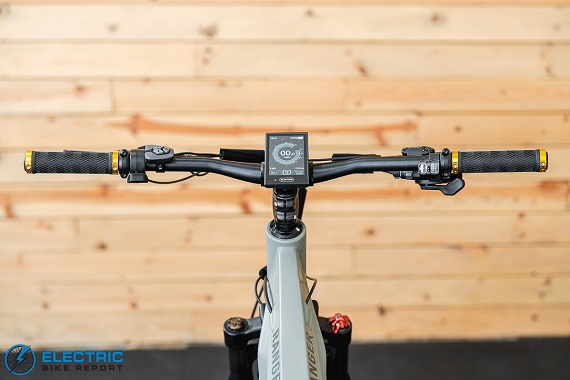
The super-wide 740mm handlebars made sure we stayed on course when riding through difficult terrain.

A Mozo coil suspension fork with 100 mm of travel absorbed plenty of bumps and jitters during our desert rides.

The rear rack is welded to the frame and can hold up to 100 lbs of cargo.
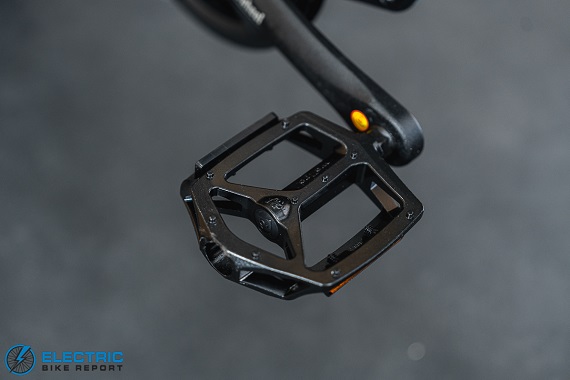
The Ranger’s simple platform pedals felt somewhat small, but worked just fine.
The bike excelled in comfort; its mostly-upright riding position felt natural and enjoyable. The memory foam saddle was supportive and accommodating, while the squishy rubber grips had the texture and “stickiness” to make them practical while wearing gloves.
Our test bike was slightly on the small side for my height of 5’-11”, but fortunately it is available in three frame sizes (S,M,L) for a range of riders under 5’-6” to over 6’-0”. Differences between the Medium and Large are relatively sparse, however, with a primary difference in seat tube length – meaning that both frames will likely feel very similar.
In terms of handling, the Ranger is big. Its wheelbase of 1190 to 1222.5 mm (depending on frame size) is comparable to many cargo e-bikes we’ve reviewed. As such, it does not have the most nimble feel, though its steering is made precise by the wide 740mm handlebars. When riding on desert roads and trails, these bars helped me to feel balanced and stable, while allowing me to direct the bike exactly where I needed it to go.
QuietKat specced a coil suspension fork with 100mm of travel, which performed very well in my testing. The bike’s tires were another huge contributor to its ride feel; with 4.5” wide tires (or 4” for the Small frame size), the Ranger felt incredibly stable and planted. Their inclusion compensated somewhat for the lack of a rear suspension; with a lower PSI, the tires had more cushion and grip on loose ground. While I had no issues, be warned: the risk of a flat tire increases as PSI decreases.
Sponsor
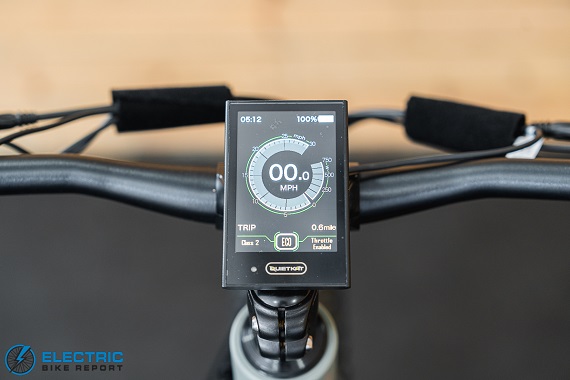
We were happy to see just three PAS settings for quick and easy power selection.

The custom branded saddle was comfortable and supportive.

The throttle is tied to the PAS setting, with three levels of power and acceleration to choose from.
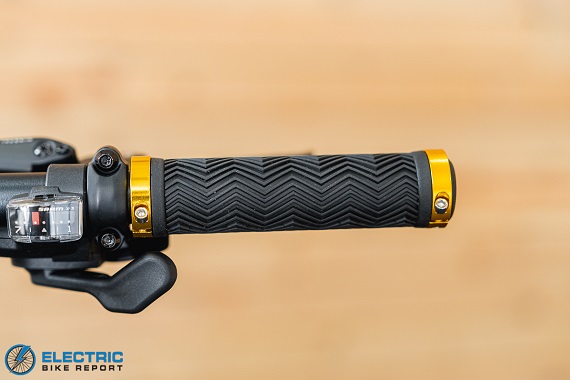
We liked the texture and squish of the rubber grips, which gave us firm control even when wearing gloves.
That critique aside, I found much to appreciate about the Ranger, including its simplicity. With just 3 PAS settings to choose from, I didn’t feel overwhelmed by options. The 7-speed drivetrain performed as needed in the Class 2 riding mode without being overly complicated, though ghost pedaling was inevitable at speeds above 22 mph.
It’s worth mentioning that QuietKat offers a myriad of customization options for the Ranger. In addition to four paint options including three camo patterns, the bike can be outfitted with a host of accessories for functionality and comfort. From suspension or dropper seatposts to vehicle racks, storage bags, and tons more, the QuietKat store can be a one-stop shop.
Overall, the Ranger’s ride quality was everything it needed to be. The bike shined in off-road environments; it had the power needed to handle loose dirt, rocky ground, and steep hills, it was comfortable to ride, and it generally felt like it belonged.
Its performance in our series of standardized tests was unexpected but admirable. Our Speed and Range Tests showed that it can cover a practical amount of ground quickly, while our Hill Test indicated that it can climb confidently. Our Brake Test proved that it has effective stopping capability. And finally, our Ride Quality evaluation proved it to be solid, stable, and both comfortable and easy to use.
While we have a few points of critique including the all-or-nothing power of its pedal assist system and the limited responsiveness of its torque sensor, we were able to overlook these aspects of the ride when the bike was in its intended environment.
The Ranger certainly has the ability to function as a commuter or errand runner, but it stood out as an off-road powerhouse first. We think it has great potential for use as a wilderness explorer, and when outfitted with some of QuietKat’s optional accessories, we feel it would be a great addition to your collection of hunting or camping gear.
Happy Riding! Make sure to let us know if you have any questions or if you think we left anything out in this review of the QuietKat Ranger down in our comments section.
Sponsor
Sponsor
Copyright
© Electric Bike Report


